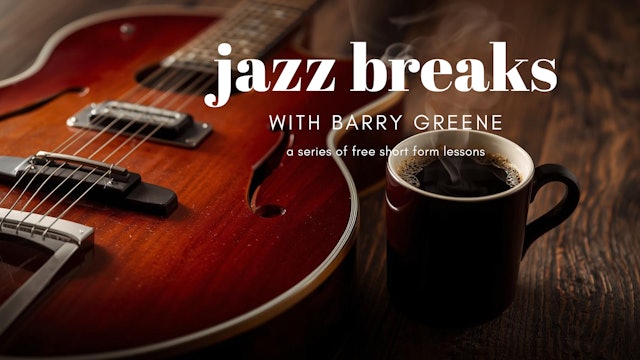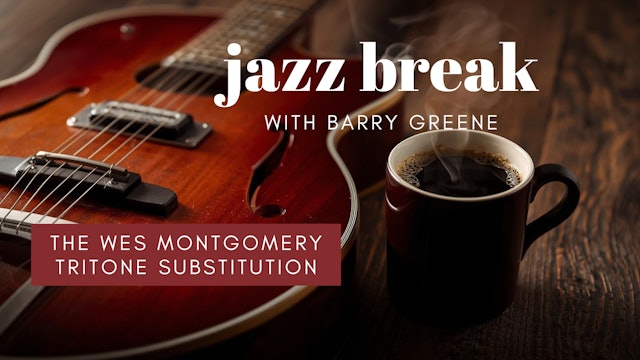Jazz Breaks with Barry Greene
Welcome to Jazz Breaks with Barry — short, free lessons you can enjoy anytime. Each episode gives you a taste of the concepts I explore in depth inside the full BGVL library.
-
The Benny Golson Progression - Jazz Break
In this lesson, you’ll learn to use a signature Benny Golson chord sequence found throughout his compositions: C–7 → C–7/Bb → A–7♭5 → D7♭9, resolving to G–7 and continuing the cycle. This progression is a powerful tool for developing chord melody fluency, improving fretboard control, and deepenin...
-
Minor ii-V's - Jazz Break
In this lesson, you’ll explore Pat Martino’s approach to simplifying minor II-V progressions by reducing the chords to their minor equivalents. This method makes it easier to navigate these challenging sequences, revealing clear melodic pathways and a more unified way to approach minor harmony.
-
The Secret Jazz Chord - Jazz Break
This lesson reveals how a single chord can function as five others, opening up six harmonic possibilities from one shape. You’ll learn how this concept simplifies improvisation—since only one chord scale is needed to navigate all six sounds—while dramatically expanding your harmonic vocabulary an...
-
Chromatic II-V's - Jazz Break
In this lesson, you’ll learn how to create smooth chromatic motion by substituting a minor chord with a dominant chord a half step higher—especially when the melody contains the ♭3 or ♭5. This approach transforms a static minor sound into a moving II-V, adding tension, release, and a touch of har...
-
Inverting 4th Voicings - Jazz Break
This lesson explores how simple inversions can transform your quartal harmony. By raising the lowest note up an octave—or moving the highest note down—you’ll uncover new three-note structures with fresh, open intervallic colors that add depth and modern flavor to your comping and voicings.
-
Mirror Image II-V's - Jazz Break
In this lesson, you’ll learn how to create new II-V ideas by using the third of the dominant chord as a pivot note and mirroring the rest of the phrase. By transposing the remaining notes up or down from the pivot, you’ll generate fresh, symmetrical lines that expand your harmonic and melodic voc...
-
Developing Vocabulary - Jazz Break
This lesson shows you how to build your improvisational language by studying and reworking phrases from classic bebop heads. You’ll learn how to extract, adapt, and connect these melodic ideas to develop authentic bebop vocabulary that naturally flows in your solos.
-
The Wes Montgomery Tritone Substitution - Jazz Break
In this lesson, you’ll learn how to apply Wes Montgomery’s approach to tritone substitutions by replacing a standard II-V-I with one a tritone away. For example, instead of D–7 → G7 → Cmaj7, try Ab–7 → Db7 → Cmaj7. This simple shift adds rich altered tones and creates the sophisticated harmonic c...
-
Triad Pairs - Jazz Break
Triad Pairs
This lesson explores improvising with triads instead of traditional linear lines. By pairing two triads—like F and G major over a D–7 chord—you’ll discover fresh intervallic textures and melodic shapes that break you out of scalar playing and add a modern edge to your solos. -
Retargeting II-V's - Jazz Break
In this lesson, you’ll learn how to create fresh harmonic colors by redirecting II-V progressions to new destinations. Instead of resolving every D–7 → G7 to Cmaj7, try substituting F–7 → Bb7 → Cmaj7 or even Ab–7 → Db7 → Cmaj7. Re-targeting opens up new melodic pathways and adds sophistication to...











